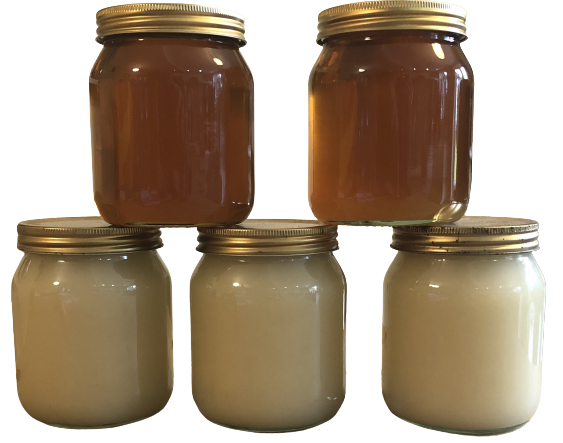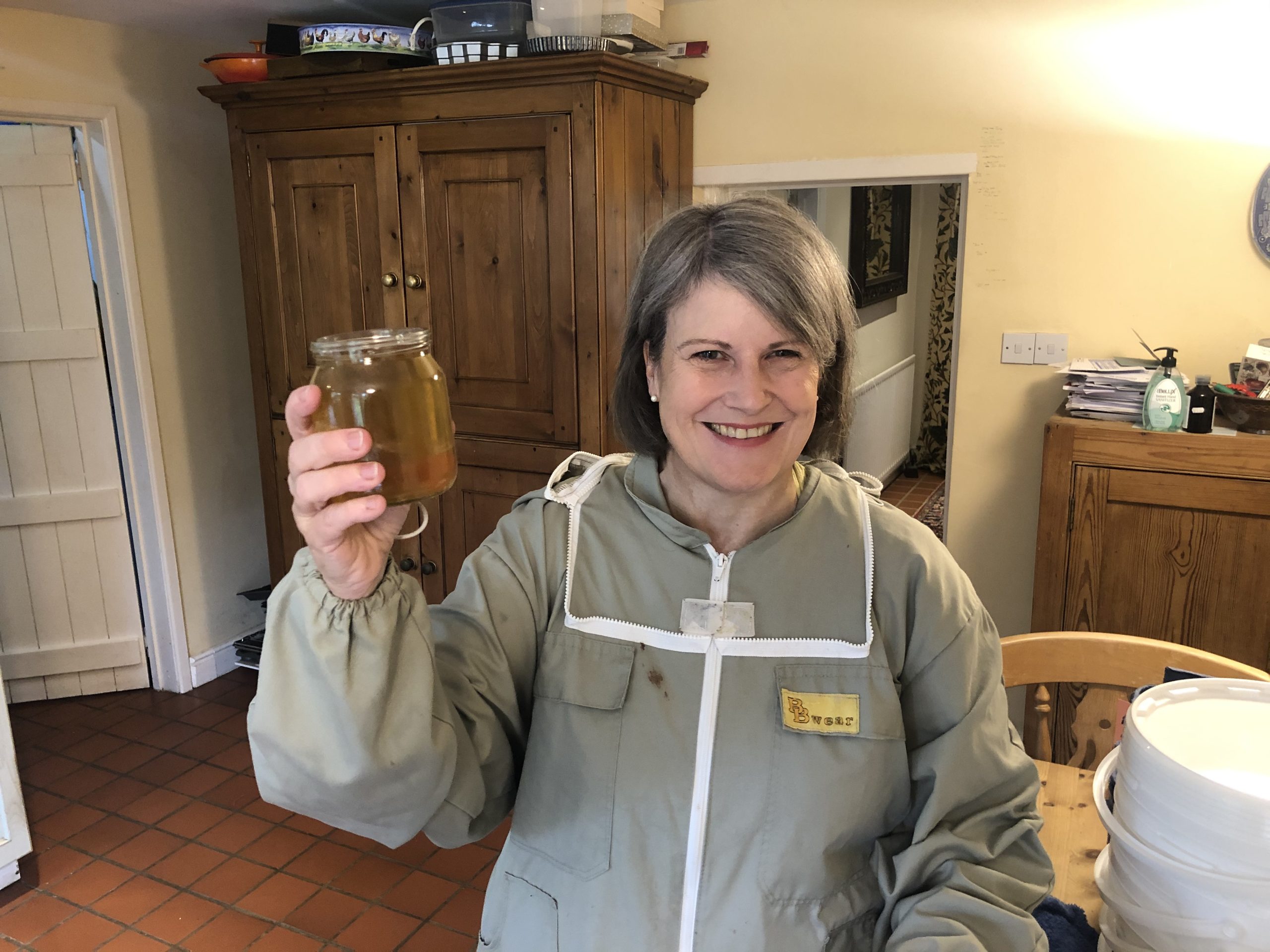Honey

Most beekeepers in the United Kingdom keep bees as a hobby and the principle attraction of this hobby is the production of honey. Whether this honey is kept and consumed over the year by the beekeeper and family, or whether it is given away to friends, relatives and neighbours, or whether it is sold to people with a sweet tooth, it can hardly be denied that honey is essential to the enjoyment that beekeepers get from their hobby.
So what do we know about this wonderful, sweet substance and its history?

All beekeepers like honey!
Some things you have always wanted to know about honey
What IS honey?
Honey is a thick golden liquid that bees make from the nectar of flowering plants. The bees produce the honey through a process of collecting nectar and then regurgitating the nectar. Then water evaporates from the nectar to produce the material we consume and know as honey. Bees perform the vital service of pollinating fruits, vegetables, and other types of food-producing plants in the course of their business of honey production.
A brief history of honey
Honey is as old as written history, dating back to 2100 B.C. where it was mentioned in Sumerian and Babylonian cuneiform writings, the Hittite code, and the sacred writings of India and Egypt. Its name comes from the English hunig, and it was the first and most widespread sweetener used by man. Honey was valued highly and often used as a form of currency, tribute, or offering. In the 11th century A.D., German peasants paid their feudal lords in honey and beeswax.
The benefits of honey
Honey is a natural sweetener that has been used for thousands of years and is known for its many beneficial elements. Some of the key components and benefits of honey include:
Natural Sweetener: Honey is a natural alternative to refined sugars, providing a sweet taste in various culinary applications.
Antioxidants: Honey contains a range of antioxidants, including flavonoids and polyphenols, which can help protect cells from damage caused by free radicals and may contribute to overall health.
Antibacterial Properties: Hydrogen peroxide, low water activity, and high acidity make honey inhospitable to most bacteria and microorganisms, giving it natural antibacterial properties. It has been used topically to help with wound healing and to soothe sore throats.
Cough and Sore Throat Relief: Honey can provide relief from coughs and sore throats. It is often used in home remedies, and many people find it soothing.
Energy Source: Honey is a source of natural sugars, primarily glucose and fructose, which can provide a quick source of energy.
Nutrient Content: Honey contains small amounts of vitamins and minerals, including B vitamins, vitamin C, calcium, and iron.
Skin Benefits: Honey can be used in skin care products and masks. Its antioxidants and antimicrobial properties can help with skin health and conditions.
Allergy Relief: Some people believe that consuming local honey may help alleviate seasonal allergies, although scientific evidence for this is limited.
Types of honey
Honey comes in various types, and its flavour, colour, and properties can vary significantly based on the nectar source of the bees. Here are some common types of honey:
Wildflower Honey: This is a general term for honey made from the nectar of various wildflowers. It can vary in flavour and colour depending on the local flora.
Clover Honey: One of the most common types of honey, it is made primarily from the nectar of clover plants. It has a mild, sweet flavour and is typically light in colour.
Lavender Honey: This honey is made from the nectar of lavender flowers. It has a delicate, floral flavour and a light amber colour.
Oil Seed Rape Honey: This is one of the most widespread of honeys in the United Kingdom. Bees adore Oil Seed Rape (the plant that produces the bright yellow fields you see in the spring), and they use it to produce large quantities of a delicious, light honey. Unfortunately OSR Honey sets very hard, very quickly and needs to be extracted as soon as possible after the flowers in the fields start to die.
Manuka Honey: Manuka honey is a dark honey produced by bees that pollinate the flowers of the Manuka bush, native to New Zealand. It is known for its strong antibacterial properties and is often used for its potential health benefits. The authenticity of Manuka honey can be a concern, however, and consumers should always be aware of the possibility that what they purchase, especially if it is relatively cheap, may not in fact be genuine Manuka Honey.
Buckwheat Honey: This honey has a strong, robust flavour and is dark in colour. It is derived from the nectar of buckwheat flowers and is often used as a natural sweetener and in baking.
Sage Honey: Sage honey is derived from the nectar of sage plants. It has a mild, herbal flavour and is often used in tea and baking.
Heather Honey: This honey is produced from the nectar of heather plants and has a strong, distinctive flavour. It is popular in the United Kingdom but is, most people think, an acquired taste.
Chestnut Honey: Chestnut honey is dark and has a robust, slightly bitter taste. It is made from the nectar of chestnut tree blossoms.
These are just a few examples, and there are many other varieties of honey, each with its unique flavour and characteristics. The type of honey you prefer will depend on your taste and intended use, whether it’s for sweetening drinks, baking, or for potential health benefits. The availability of these honey types can vary by region and season.
How long can honey be kept?
Honey is a natural product with a long shelf life, but proper storage is essential to maintain its quality and prevent spoiling. Here are some tips on how to store honey:
-
Seal the Container Tightly: Honey should be stored in an airtight container. Make sure the lid or cap is securely fastened to prevent air from entering, which can lead to crystallisation.
-
Store at Room Temperature: Honey can be stored at room temperature, ideally between 70°F and 80°F (21°C to 27°C). It does not require refrigeration. Storing honey in a cool, dark place helps maintain its liquid state and prevents crystallisation.
-
Keep It Dry: Moisture can cause honey to ferment or develop mould. Ensure that the container and the area where you store the honey are dry and clean.
-
Avoid Direct Sunlight: Keep honey away from direct sunlight, as exposure to UV light can cause it to deteriorate over time.
-
Use a Dry Spoon: When scooping honey from the container, use a dry spoon or utensil to prevent introducing moisture into the honey.
-
Keep It Clean: Make sure the rim and opening of the honey container are clean and free from any honey residue. This prevents crystallisation and contamination.
-
Separate Types of Honey: If you have multiple types of honey, store them in separate containers to preserve their distinct flavors and characteristics.
-
Check for Crystallisation: Honey naturally crystallises over time. If your honey becomes solid, you can gently warm it to liquefy it again. Place the container in warm water (not hot) or use a microwave with short bursts of low heat, stirring in between until it becomes liquid again.
-
Avoid Metal Containers: It’s best to store honey in glass or food-grade plastic containers. Avoid using metal containers as honey can react with certain metals and affect its flavor.
-
Date the Container: Consider labeling the container with the date of purchase to keep track of the honey’s freshness.
Honey is known for its long shelf life, and if stored properly, it can last indefinitely. Edible honey has even been found in pots in Egyptian pyramids! Very few other foodstuffs keep for 3000 years! Even if honey crystallizes or changes in appearance, it is still safe to consume, and its flavour and quality can be restored by gently liquefying it as mentioned above.
Proper storage helps preserve the characteristics and flavour of honey, making it enjoyable for a longer period.
